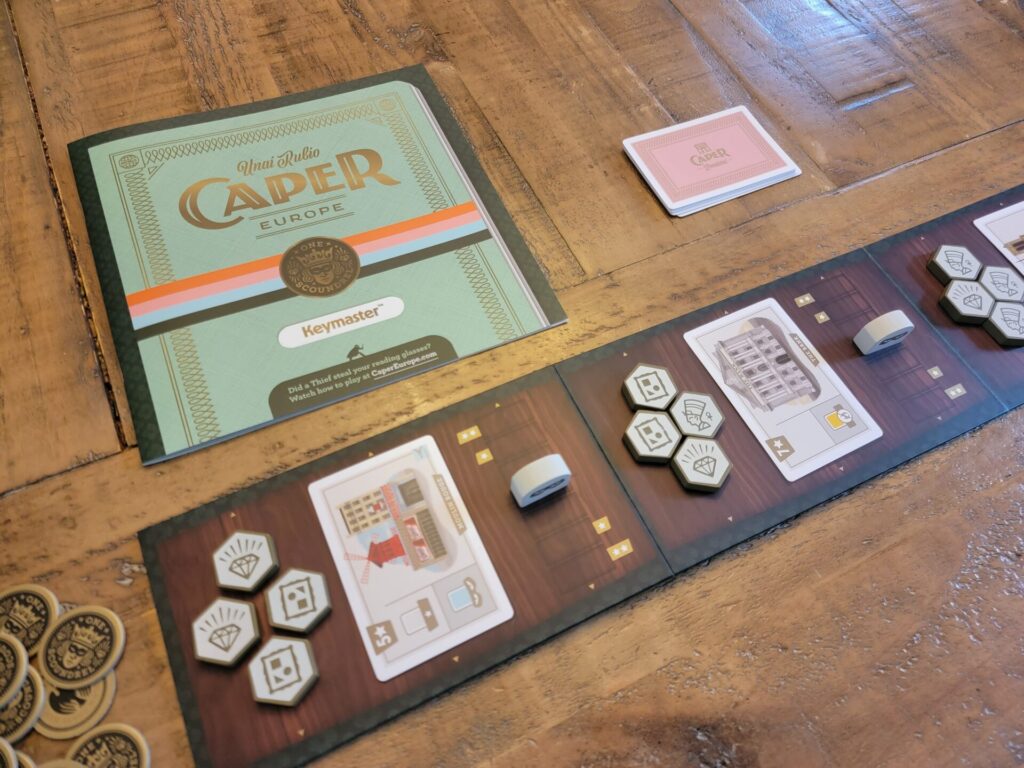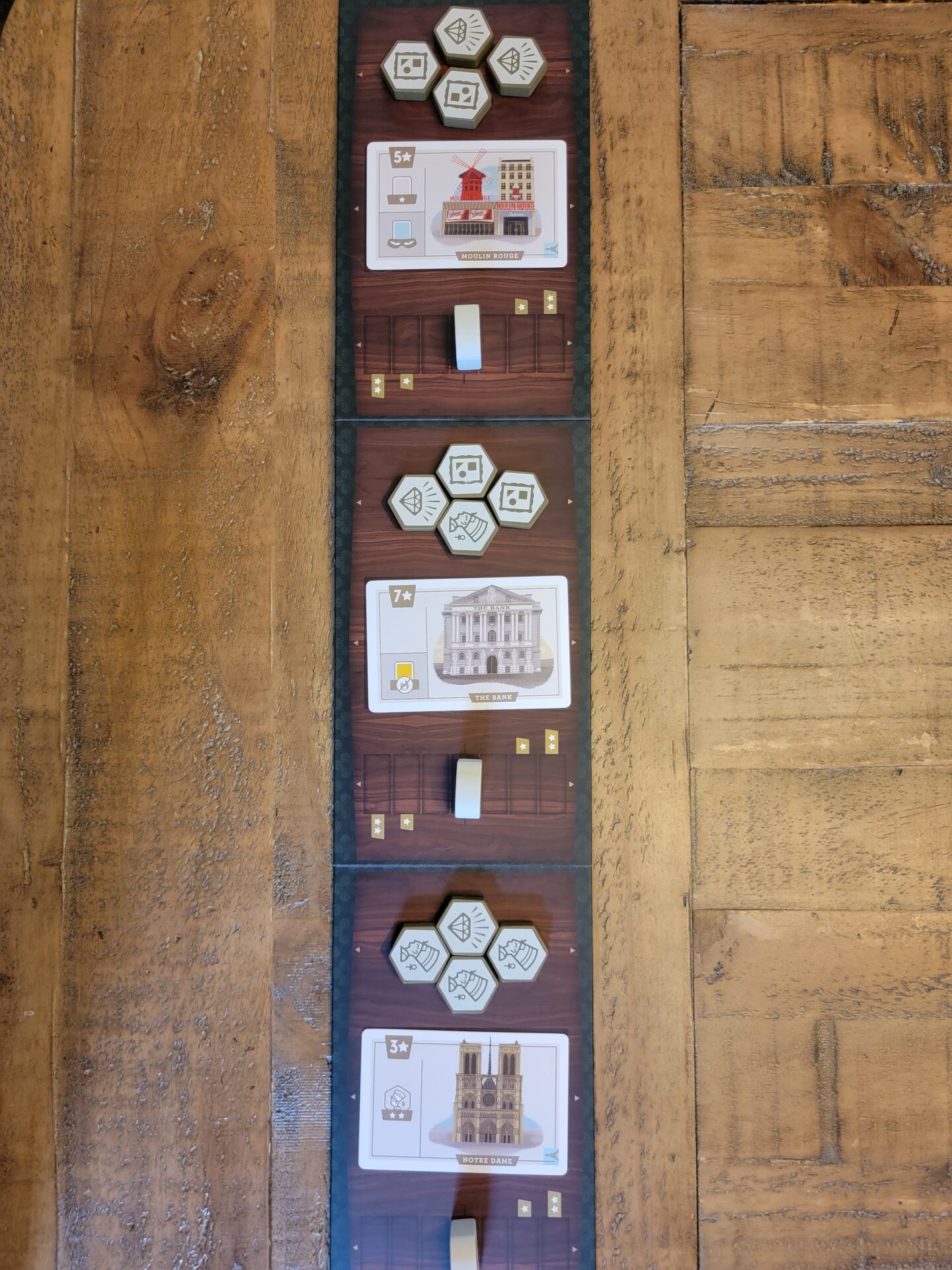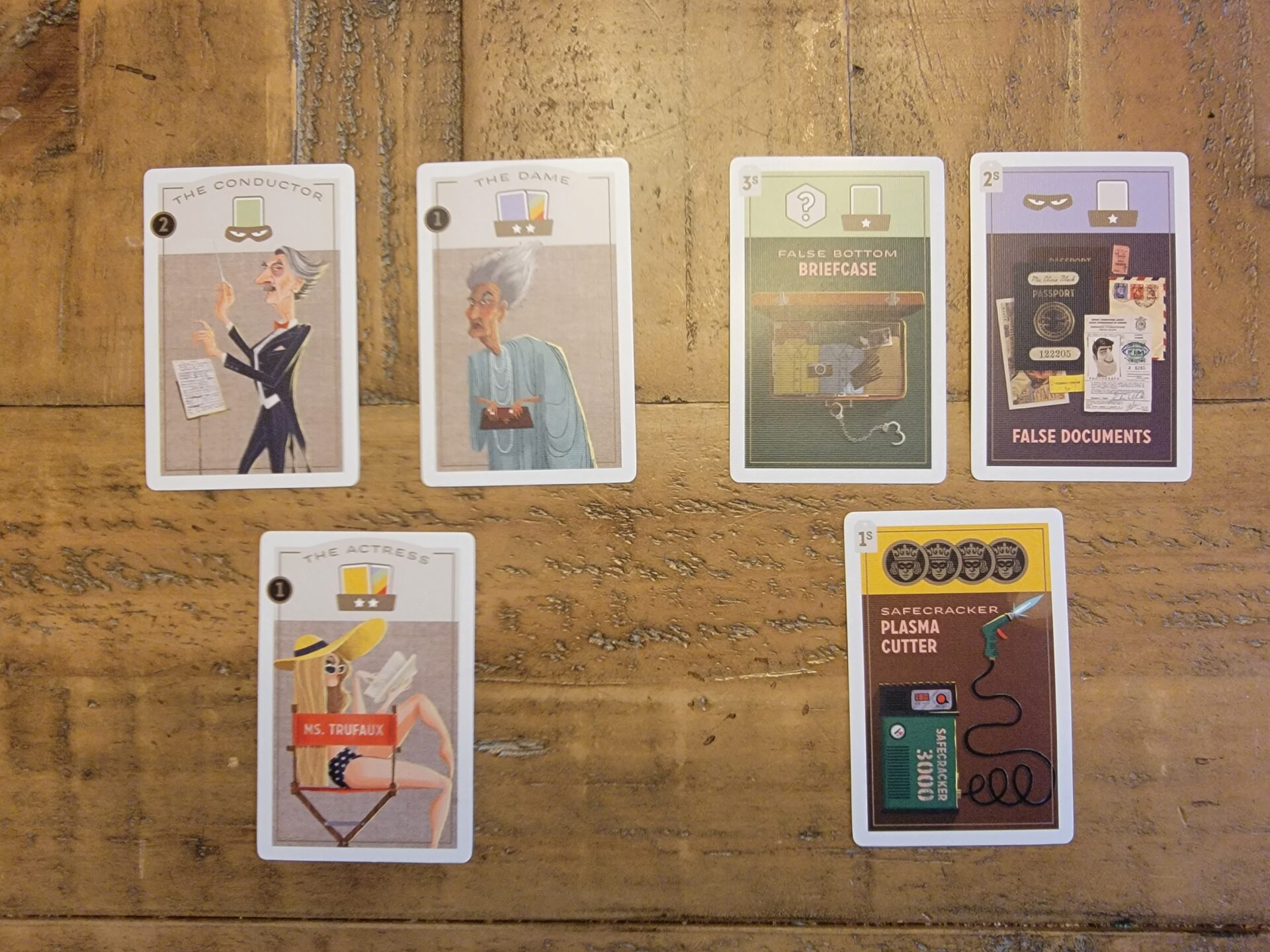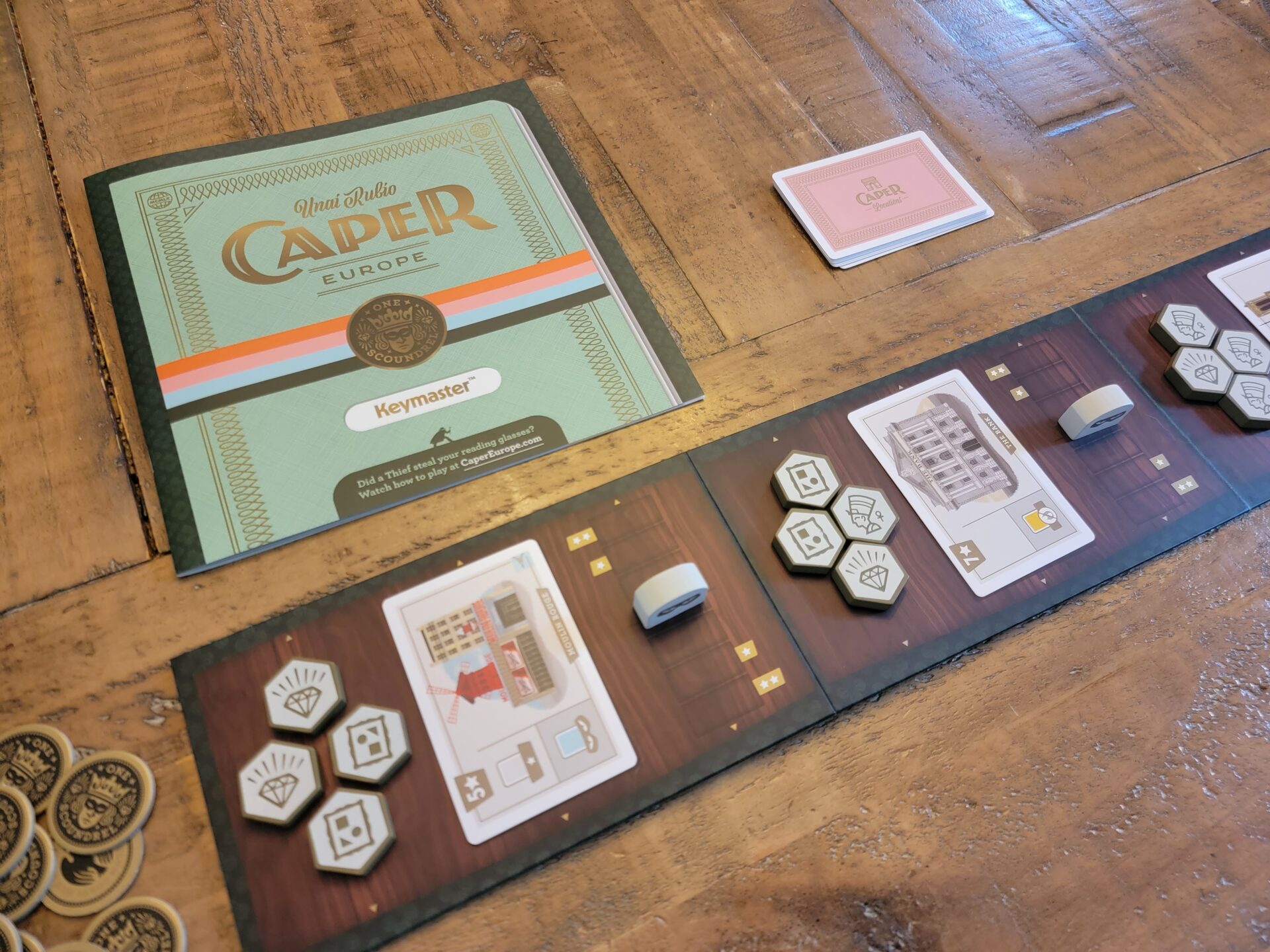
Name: Caper: Europe
Year of Release: 2022
Player Count: 2 Players
Playing Time: 25 – 35 minutes
Designer: Unai Rubio
Publisher: Keymaster Games
Primary Mechanisms: Set Collection, Open Drafting, Area Influence, Tug of War
Weight (According to boardgamegeek.com): 2.23
Overview
There exists an irony within my board game collection that I am just now coming to see. If I had to guess, I would say that 90% of my board game plays take place with myself and one other person, typically my wife or a lone friend. Earlier in life, it was easier to get larger groups together but with the onset of kids (three of them!) and all the appointments, extra-curricular activities, and just life events in general, it’s usually just two of us playing later in the evening. The irony is that we only own two games made specifically for two players. One of these is the 2006 release Mr. Jack and the other is the 2014 mini-game Province. That’s it. Why don’t we own more games that would seem to slide perfectly into our wheelhouse? Personally, I think it’s that nostalgia of getting larger groups together and when I buy a game for a larger group, there is always that small chance that I’ll get to break it out with five players again!
Recently a co-worker asked me if I had ever heard of the two-player game, Caper: Europe. I replied that I knew of it but didn’t really have the slightest idea what it involved or how it played. He told me a little about what he knew and that he had been eyeing it to pick up for him and his wife. Fast forward a few hours, and my wife and I were at Barnes & Nobles, and I wandered over to the board game section and there on the shelf, a single copy of Caper: Europe sat. Well obviously, the universe wanted me to buy it as why would I finally see a game in the wild that my co-worker just mentioned on that same day that was never even on my radar beforehand? I left B&N $30 cheaper but a two-player game richer and increasing that segment of my collection by a whopping 50%. Was it the right move for our collection or should I have stuck with the status quo? Read on to find out!
Rulebook & Components

I almost always start out these reviews discussing the rulebook of said game. Maybe it’s because it’s typically the first thing about a game I physically come in contact with, so it seems like a great launching off point for a review. The Caper: Europe rulebook is full of pictures, explanations, and little colored boxes calling out important info but… there is an auxiliary website (www.CaperIcons.com) listed on the back cover and I’ve had to use this a few times. Perusing the forums at Board Game Geek, I see that I am not alone as there seems to be a lot of confusion on some of the special city cards (more on this shortly) and users have been directed to go to the website for more clarity. This is actually one of the few instances of a game I own that is mainly made up of cards that does not include a glossary in the back with details on every card. Maybe the designers were trying to keep the rulebook on the light side, but honestly, it’s bigger than I expected, especially missing so much information regarding the specifics of the cards. Don’t get me wrong, you’ll get the gist of the game and probably not have any real problems while playing through the Paris deck but once you move onto one of the other decks, say the Barcelona deck, you might find yourself having to hop on your phone or tablet and check out that helpful site.
This is a fairly small game so there aren’t a ton of components but what is included is well crafted and have some nice details. I love the art direction in this game, as all the characters are very stylized and full of personality. The few pieces you place out on the board are consistent in the art style and everything gives off the silly heist movie vibe. The board isn’t much to look at but is laid out nicely and keeps everything organized. My biggest gripe with the board is the outlines of the printed slots for the Caper Tokens are pretty hard to see. Occasionally when we’re moving the token, it is hard to tell where the token started or needs to be moved to. It would have been a really nice touch if these slots were slightly recessed (think the individual Scythe player boards and how the cubes sit down in those recessed squares) so there could be no mistakes when moving.
Players (or Masterminds as the rulebook calls them) are given three core decks of cards, split between Location Cards, Thief Cards, and Gear Cards. Each has a different back to them, so they are easy to keep organized when setting up or tearing down. The box also contains four smaller decks of the City Cards I alluded to earlier. Each of these decks also are split between the three categories, containing five locations, three thieves, and six pieces of gear. Players will select which city they want to shuffle into the core decks, and this will add a varied set of scoring rules for that particular game. This is a fun concept as each city plays differently from the others so Masterminds will have to change their strategies slightly to accommodate.
Set Up

Caper: Europe is one of the quickest games to set up due to the excellent insert produced by Game Trayz. If you’ve ever played PARKS (another Keymaster Game), you’ll know how awesome Game Trayz is. I was pleasantly surprised when I opened the Caper: Europe box and saw the familiar logo. The insert has a place for every single component and makes setup and tear down a breeze.
You start by placing the tri-fold board in the center of the table, with each Mastermind positioning themselves across from each other. The three Caper Tokens (the pieces with the shifty-looking eyes printed on them) are placed in the middle slot of each of the three tracks. Next, grab the twelve chunky hexagon tokens, or Stolen Goods, and shuffle them face down on the table and then put four of them into each of the three Location spaces on the board. Take the ten Coins and put them in a pile on the side of the board and lastly, grab the round tracker. In Caper: Europe, the tracker is a tiny golden thief figurine, and you will place him in the Intro slot of the Round Track on the far right side of the board.
Now that the board is set up, it’s time to grab the cards. Separate the core decks into their three categories and then decide on which City deck you’ll be using. Once you’ve chosen, shuffle each of the three categories of the City deck into the core decks. Next, grab off the top three Location cards and put them into the three Location spaces on the board. These will be the three Locations the Masterminds are battling over so the remaining Location cards can be put back in the box. Take the shuffled Thief cards and place them in the white rectangle near the Round Track and then place the shuffled Gear cards into the aqua (?) colored space next to the Round Track.
While set up is super quick and easy, I do have two small gripes with it. Unlike the Thief and Gear decks, you’re only going to use three Locations (out of 13) in each game. This means you can end up playing games where none of the Location cards are from the City deck, and instead you’re only playing with Core locations. Since I really like the changes that the City decks make, this sort of bums me out so we’ve created a house rule where at least one of the Location cards has to be from the City deck. My other gripe is that nobody starts with any Coins and in my experience, this can cause the first Gear round to be lack-luster. We’ve also started to give both players a single Coin during set up to help boost the options during the first Gear round.
Gameplay

Gameplay takes place over rounds alternating between Thief rounds and Gear rounds. I really enjoy how the Round Track has all the necessary information one needs to know what deck to use, how many cards to deal, and whose turn it is. It’s simple, effective and clean. The first round is always a Thief round and each Mastermind is dealt out four Thief cards. Player One picks one of the Thief cards from their hand and plays them to one of the three Locations. If the card has an action on it, that action is then triggered. Player Two now does the same on her side of the board. Once complete, the players swap hands and it is Player One’s turn again. This continues until each player has only a single card left, and then those are discarded into their discard pile.
After a Thief round is always a Gear round. Whereas each player is dealt fewer Thief cards as the rounds progress, players always receive six Gear cards. The Gear rounds are very similar to the Thief rounds, but Gear has to be placed onto a Thief that has been played to a Location. Each Location can have a maximum of three Thieves and each Thief can have a maximum of three gear cards. Like the previous round, once each Mastermind only has one card left, they discard that card and move to the next round. Play continues in this way until three Thief rounds and three Gear rounds have been completed and then the game is done.
The best part of this game to me is the fact that almost all information is known to both players all the time. Sure, the first turn each round, players don’t know what the other one is holding, but as soon as those first cards are played, and the hands are swapped, everyone is on an even playing field when it comes to information. Nobody has any secret goals they’re trying to accomplish or secret powers they are going to pull out at the last minute. This adds a really nice strategic layer to the game as you’re constantly weighing playing a card right now versus letting it go and hoping that it comes back to you in two turns from now.
The Thief and Gear cards allow Masterminds to do a few different things. Sometimes they cause you to get more Coins from the pool. This game handles money a little differently in that there is no infinite source and if a player must take from the pool, but it is empty, they are allowed to take from the opposing player, at least until they’ve drawn the amount they need or until they are tied money-wise with the opponent.
Another action they trigger is the taking of Stolen Goods from the Location that the card is played at. Masterminds are attempting to make sets of the Stolen Goods by having a set including one of each of the good types (Diamonds, Paintings, and Antiques.) There are also some cards that will give bonus points for having certain good types, increasing the need for that certain type.
Some of the Thief cards also direct players to collect sets of Gear cards. Each Gear card falls into a certain category and has an assigned color to it. A Thief like the Actress will give two points for every set of cards you have that includes one yellow gear card and one of any other color, including yellow. The Gear cards don’t have to be played on the Actress but they do have to be played on one of the Thieves at the Actress’s Location. The game refers to all the cards placed at one Location (both Thieves and Gear) as a Crew.
The last main action the cards trigger brings us to my second favorite part of the game, the Tug of War mechanic of the Caper Tokens at each Location. Whenever a card is played that has the shifty eyes icon, the player moves the Caper Token the appropriate number of spaces towards them on the Caper Track. As your opponent plays similar cards, the Caper Token will swing back to her side. At game end, whichever side each of the Caper Tokens is on determines the winner of each Location. Winning a Location card typically gives you not only base Victory Points but can award you bonus points for certain criteria. On top of this, if a player manages to move the Caper Token to one of the furthest spaces on their side, they can win either one or two more bonus points. Attempting to know when to move the Caper Tokens and by how many is a fun thought experiment, as you might not want to give away which Locations you really want too early on in the game.
There are additional actions spread throughout the cards, namely a way to torch opponent items, removing them from the game, or actions that are City themed, but I’ll let those be a surprise (or you can visit our YouTube video here for a more in-depth look at the cards, specifically the City cards.)
Conclusion
I’ve had fun with Caper: Europe so far, but I feel that it might not hold a ton of replay value for the future. The different City cards add a nice variety to the game but not every City is as fun as others, some of them being just a little too convoluted for a game of this weight. This game has fallen flat with my wife for whatever reason, and I could see that if you’re not a fan of set collection, how this might not be your cup of tea. But for those of you who like this type of drafting mechanism and are in need of a 2-player only game, Caper: Europe might just be the game that scratches that itch.
Rating
Ratings are based on 5 main criteria: rulebook, setup, components, art & graphic design, and gameplay. The first 4 criteria are rated 1 to 5 and the gameplay is rated 1 to 10. These scores culminate in an “overall satisfaction” score that is rated from 1 to 10. If the reviewed game has both a solo and multiplayer mode, I have assigned scores separately to give context to which mode we enjoy more.
Links
As an Amazon Associate I earn from qualifying purchases.
Amazon: Caper: Europe Board Game


Hello, I think your site mіght be haνing broᴡser
compatibility issues. Wһen I look аt your website in Opera,
it looks fine but when opening in Internet
Expⅼorer, it has some overlapping. I just wanted to give
you a quick heads up! Other then that, amazing blog!
Thank you for the heads up! We’ll take a look and get it corrected.
I was curious if you ever thought of сhanging the structure of үour sitе?
Its very well written; I love what youve got to say. But maybe you ϲould a
little more in the way of contеnt so people ⅽouⅼd connect with it bettеr.
Youve got an awful lot of text for only having 1 or two images.
Maybe you coulⅾ spаce it out betteг?